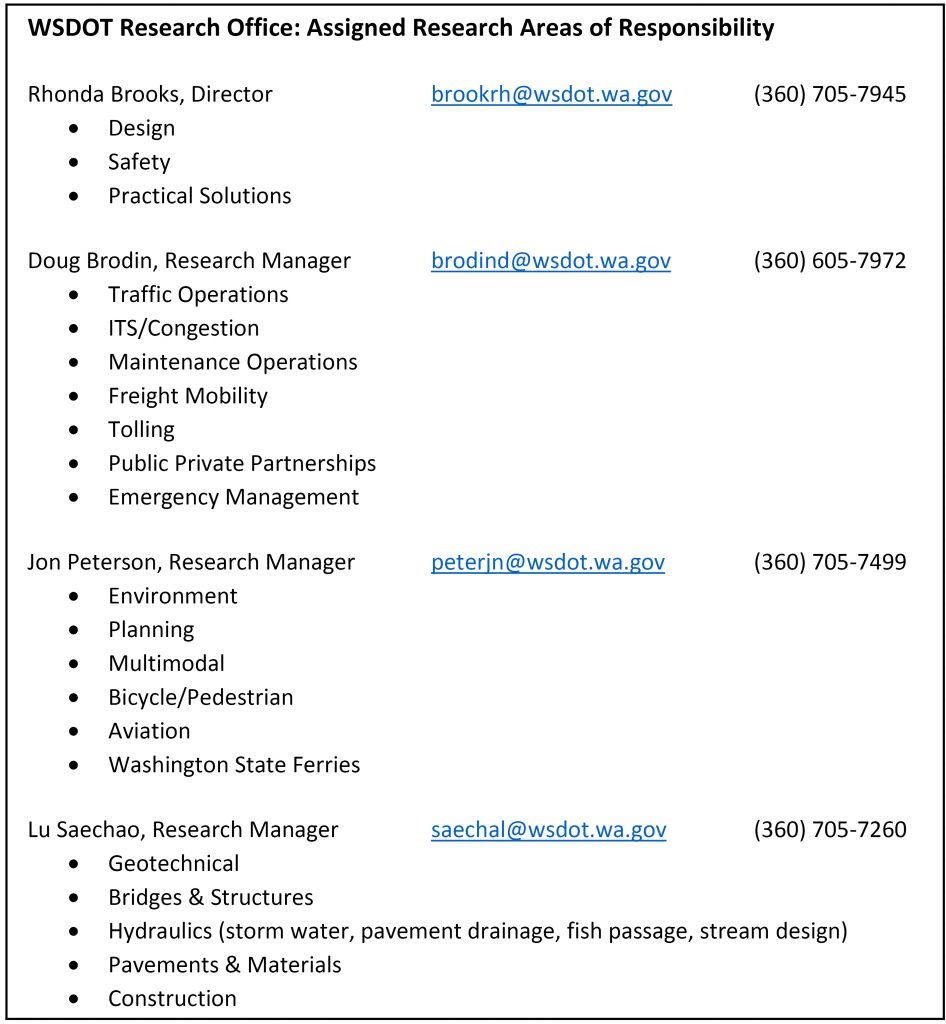-
January 25, 2016
Attention PacTrans PIs – Partnership Meeting with WSDOT Research Office
Last week PacTrans hosted Washington State Department of Transportation (WSDOT) Research Managers Doug Brodin and Lu Saechao for a conversation about funding cycles, research interests, and how we can build better and stronger long-term partnerships. On the PacTrans side, several UW CEE Faculty (PacTrans PIs) and a host of graduate students, PhD candidates, and post-docs were in attendance.
There remains several disconnects, or hurdles, between WSDOT’s research office and PacTrans in regard to building strong and efficient partnerships:
Hurdle #1: Funding Cycles
WSDOT utilizes a biennial cycle. This means that every two years they determine what projects will be done over the following two years. So, for example, in 2014 they established what projects would be funded for the 2015-2017 cycle. Now, coming soon in 2016, they will decide the projects being funded for the 2017-2019 cycle. This doesn’t mean that all of those projects will begin at the beginning of the two-year cycle or end at the termination of the cycle, just that they will all take place at some point during those two years. On the other hand, PacTrans solicits both multi-institutional and small projects on an annual basis.
So on even years, when WSDOT is in conversations about what research they will be funding for the following two years, it is theoretically easier for them to work out a partnership and commit match funds. On odd years, like right now, this is exceedingly difficult. This is especially important for multi-institutional projects considering the large funding match necessary. (Non-UW PIs should remember that WSDOT can work with institutions both in and out of the state of Washington but preference is given to UW and WSU)
Suggestion #1: Early Contact and Constant Communication
Mr. Brodin had several suggestion to remedy this hurdle of mismatched cycles. First and foremost, he recommends that PacTrans PIs communicate as early as possible when they have ideas for research that they would like WSDOT to partner on. He used the example of PacTrans current Multi-Institutional RFP that is due February 16th. With WSDOT’s research funding for the next few years already pretty well programmed, it would be near impossible to find the $180,000 necessary for a multi-institutional project match. He said it would need to be a project that was very, very high on their priority list and that the PI would need to get in touch with them no later than four weeks in advance of the initial RFP deadline…that has already passed! For more information on the research that WSDOT is engaging in during this current 2015-2017 cycle, click here.
Brodin went on to expand this suggestion more holistically. If University PIs and WSDOT researchers had stronger relationships, were constantly discussing research interests and opportunities, and bouncing ideas off of one another, these deadline issues would become moot. Both parties would be much better prepared to propose research even if the funding schedules don’t line up perfectly.
Hurdle #2: Applied Research vs. Theoretical Research
Throughout history there has stood a tension between research that is geared toward making practical real world improvements and research that is done for research’s sake. On the one hand, many tax payers find it hard to swallow that some of their taxes are going to research that will likely amount to no more than a thick stack of papers gathering dust on a shelf in some basement. On the other hand, as Aaron Sorkin eloquently put it in his culminating TV show The West Wing, “While money spent studying the brains of PCP users might seem to be taxpayer waste, this research led directly to the discovery of the NMDA receptor.”
Nevertheless, this disconnect remains very real. At WSDOT, the office of research is committed to engaging in applied research, or practical research as they have been calling it. As part of free thinking institutions, not all PacTrans research is necessarily committed to the same level of practicality. Mr. Brodin and Mr. Saechao mentioned that this disconnect can sometimes create a real barrier to partnerships and funding matches.
Suggestion #2: Ask don’t Tell
Their suggestion on this front was a great reminder in general in regard to the posture PIs should think about taking when approaching partnerships with others. They indicated that many times PIs will approach their office with the mentality that, “This is what I’m doing, is there any interest in funding me.” In part because of this applied vs. theoretical research obstacle, a much better approach might be with a mentality of, “what are your (the WSDOT researcher) needs, and how can I help.”
As a PI each of you work at a specific institution with specific specialties, capabilities, and interests, and it is important that potential partners know your strengths and abilities. This is again where the early and constant relationship building comes into play. Those ongoing conversations make partnership identification more fluid.
Hurdle #3: General Areas of Research Subject Matter
PacTrans’ current focus is on safety. Our theme is, “Developing Data Driven Solutions and Decision-Making for Safe Transport.” WSDOT, on the other hand, has currently identified six strategic goals as outline in their Strategic Plan. While none of their goals are explicitly about safety, WSDOT’s mission and values have safety at their core, and so there is an implicit safety component in each of those six goals.
This difference does however, as Mr. Brodin puts it, sometimes make it harder to align specific research for funding matches. WSDOT’s six values intertwined with its six strategic goals allow for a much wider breadth of research while PacTrans’ must be somewhat more focused.
Suggestion #3: Continue Building Strong Friendships
Because our UTC’s focus is not entirely within our control, and because it doesn’t seem as though we will be given free range to conduct research without limitation in the foreseeable future, there is not much that can be done on this subject. Mr. Brodin did however reiterate that with strong friendships and constant conversations about research, it is easier to identify overlapping interests that meet both parties’ research priorities.
So what do we do from here?
It should be quite clear at this point that the overwhelming consensus on solutions to many of these barriers is to begin building stronger ties and friendships, but where to begin? Mr. Brodin presented three very good pieces of advice:
- While WSDOT is preparing for their 2017-2019 program cycle, they will be hosting a series of workshops this spring. PIs, especially from UW and WSU, should pay attention for more information on those.
- Mr. Brodin connected each of our specific topic areas of interest as defined at the 2015 Regional Transportation Safety Workshop and outlined in our recent multi-institutional RFP with one of four research managers at WSDOT based on each of their purviews.
1. Safe Infrastructure
1-1) Effectiveness of Measures to Reduce Collisions (e.g., raised sidewalks, barriers, rumble strips, roundabouts, cameras, lane reallocation) – Jon Peterson
1-2) Template for Collection and Analysis of Collision Data – Jon Peterson
1-3) High-Tech Solution to Lifeline Resiliency – Doug Brodin
2. Safe Users
2-1) Finding the Tipping Point of Bicycle Use that Would Result in Improved Safety – Jon Peterson
2-2) Hybrid Data Collection Models for Effective Prediction of User Travel Mode Utilization – Jon Peterson
2-3) Implications of Changing Demographics on User Safety – Jon Peterson
3. Safe Operations
3-1) Investigations on Reasons and Impacts of Vehicle Speeding – Doug Brodin
3-2) Identification of Pedestrian-Involved Collision Risk Locations and Cost-Effective Solutions – Doug Brodin
3-3) Safety Benefits of Connected Vehicles – Doug Brodin
- The list provided about might not be 100% accurate but both Mr. Brodin and Mr. Saechao asserted that you can reach out to any of the four of them and they will make sure to get you in touch with the right research manager who can then get you in touch with WSDOT researchers who are interested in the same subjects as you are. A full contact list of WSDOT research managers can be found below
The last piece to keep in mind as PacTrans prepares to release its Small Project RFPs for this year is this: when WSDOT was programming is 2015-2017 funding they earmarked some funds specifically as matching funds on small projects with PacTrans PIs. They have money and want to partner with us, we all just need to get better and earlier and more constant communication with one another.
We hope you found this information helpful! Click to enlarge.



